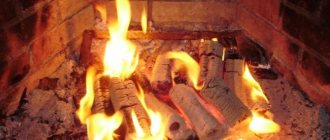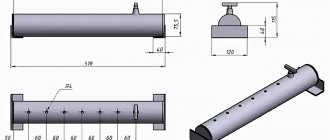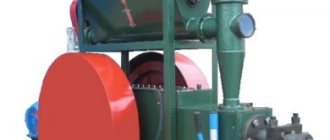Advantages of the presented material
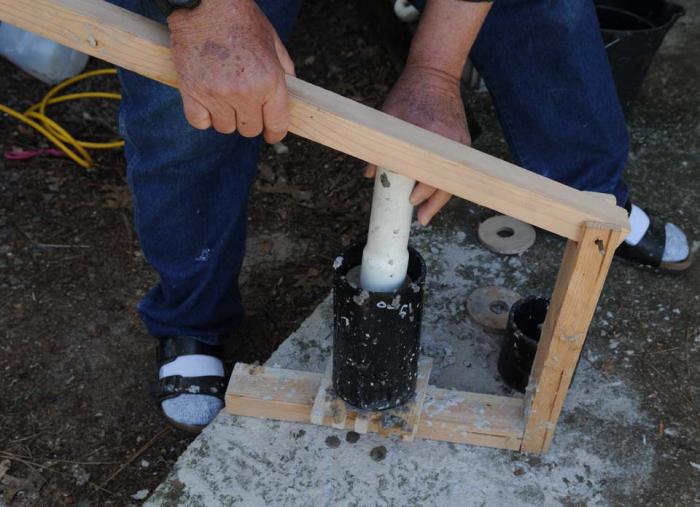
So, the main advantages of these elements are as follows.
1. Making a fuel briquette with your own hands is quite simple, so you can do it yourself, using simple devices - presses. Plus, you can even start your own business.
2. Long duration of burning. The briquette can burn from 1 to 4 hours. At the same time, it constantly emits heat.
3. The minimum amount of smoke, sparks.
4. Environmental friendliness, as fuel briquettes are made by hand from plant and other natural materials.
5. Profitability. The cost of one ton of such fuel is significantly less than the same amount of coal or firewood. At the same time, energy efficiency is much better.
6. Practicality. The ash that forms after the briquettes are burned can be used as fertilizer.
7. Ease of storage. The presented material does not take up much space, it can be in plastic bags. Moreover, it can be stored for a long time in high humidity conditions.
8. Application in all types of fuel equipment: fireplaces, boilers, stoves.
9. Simplicity in storage.
Production
For the production of briquetted fuel for heating a summer cottage or a garden house, crushed waste and clay will be required. They are mixed in a ratio of 10: 1, adding a little water until a pasty mass is obtained.
The quality of combustion will depend on how evenly the original components are mixed, therefore mixing is best done using a household construction mixer (concrete mixer).
From special equipment for the production of small batches, it is necessary to make a cellular form.
For trial batches, the mold can be made from planks. The size of the cells is chosen arbitrarily, based on the desired form of obtaining briquettes.
Some summer residents press the mixture in old pots, boxes and other unnecessary household containers. However, a rectangular shape is preferable, since rectangular fuel blocks are more convenient to store.
The wet mass is placed in the mold cells and tamped. The quality of homemade fuel depends on the degree of compaction.
To prevent the briquettes from crumbling and scattering in the hands, it is advisable to lay several layers of newsprint on the bottom of the mold (or under the mold when using cells without a bottom).
Drying is done naturally in the air. On sunny summer days, this process does not take long. After removing the briquettes from the mold, they are placed under a canopy, in a stack with gaps, where they are dried in a draft.
Areas of application of the material
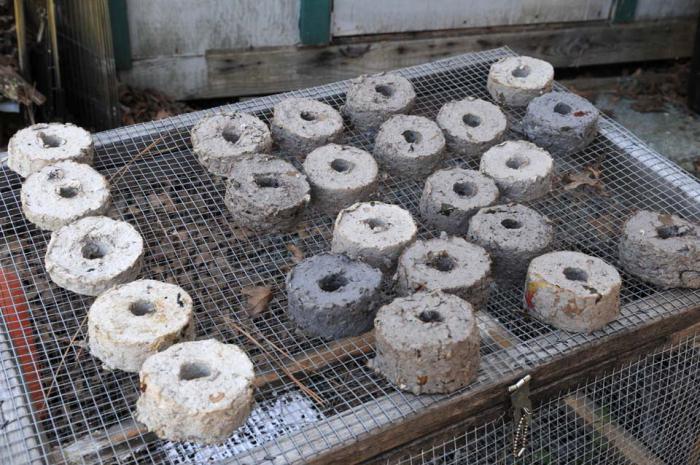

Before making a fuel briquette with your own hands, you need to figure out where it can be used. Most often, the material is used for heating residential buildings, educational institutions, and catering establishments.
In addition, fuel briquettes can be used in warehouses where wood materials are dried and stored. Industrial enterprises also often use the presented type of fuel in combination with other materials. In any case, the presented material is the most efficient and economical, especially in comparison with other types of fuel.
Types of paper mulch
Over time, each person accumulates mountains of old periodicals, unnecessary papers, cardboard boxes. All this can be used as a material for mulching in the country.
Covering elements are divided into organic and inorganic.The former are considered the most useful. These include grass (plucked, mown), straw, sawdust from a tree, small branches, foliage, humus.
Mulch functions:
- retention of moisture in the ground (this is especially important during dry periods);
- protection from direct sunlight;
- regulation of optimal temperature and humidity indicators in the soil;
- improving the structure of the soil;
- weed removal;
- increased fertility;
- saving time, effort, money for the gardener.
Completely open soil suffers from drying out of its top layer. Nutrients are washed out of it, and beneficial insects and microorganisms find themselves deep in the ground, humus is mineralized. This leads to a rapid depletion of the soil.


The material stops the growth of wheatgrass.
Cellulose mulch is classified as inorganic. There are many variations of it:
- Paper. Used in cut form, shredded with scissors or shredder. This is an economical and safe coating option. It raises the soil temperature by 2-3 degrees, but the plants do not suffer from high temperatures under the layer. The method is suitable for preparing trees, shrubs, flowers for wintering. Can be used in spring as protection against return frost.
- Cardboard. This material is used as a protective layer from weeds, as well as to retain moisture and bait earthworms. Cardboard is a natural biohumus: it decays until the next season, therefore it is suitable as an additional fertilizer. Weeds after its application are absent until about July. On top you can put cut grass, straw, soil, humus, peat. Cardboard is soil-safe because it uses bone glue, not synthetic glue.
- Newspapers and magazines. This type of mulching material is used, like paper, in a cut into strips. The paint - black and colored - is harmless as it does not contain chemical impurities. Tin and lead are not included in the composition: the printing house has long abandoned paints containing these elements. Mulching with newspapers is more effective than covering plantings with straw and black film. To protect the plants, it is necessary to lay a layer of 15-20 cm. As a result, the yield of raspberries, tomatoes, corn, soybeans and other garden crops increases.
It is better not to use glossy magazine products as a material for covering plantings: the sheets of such publications are covered with varnish, which includes acrylic compounds.
What raw materials are used in production?
Before making a fuel briquette with your own hands, you need to select the necessary source material and equipment. First, let's figure out what the product can be made of. So, most often wood and plant waste is used in production.
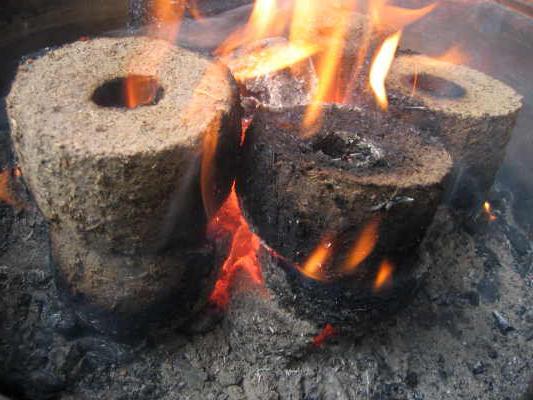

For example, you can make a briquette at home from vegetable husks, sawdust, and straw. In addition, it is also allowed to use for production such materials as fallen leaves, shavings, dry plant stems, chips, seed husks.
Naturally, for production, you also need water, clay and other substances that can glue the raw materials. In some cases, starch can be added. In general, you can use any combustible waste that is uselessly lying on your territory for making briquettes.
How are straw briquettes made in production?
The manufacture of such fuels is of interest to many homeowners and farmers. After all, it makes no sense to burn straw in its original form, only gunpowder burns faster. Alternatively, you can consider burning it directly in bales, as is often done on large farms. However, in this case, a boiler with a large furnace volume is needed, where the bales are loaded mechanically.It is clear that this method is not suitable for heating a private house, but straw fuel briquettes are quite suitable.
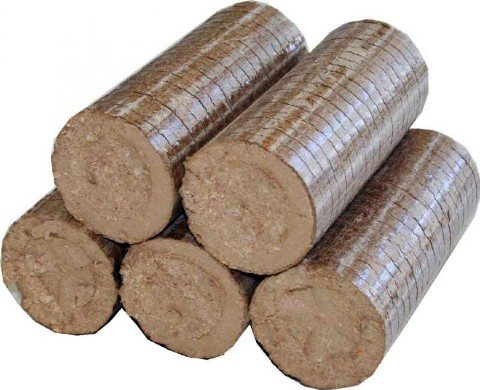

In terms of production technology and calorific value, straw biofuels are very close to briquettes made from wood waste. The calorie content of straw compressed according to all the rules is approximately 4 kW / kg, which is slightly less than that of the same sawdust product. The question is how to properly seal it in order to get a high-quality "brick" or "sausage".


The industry uses the following equipment for the production of straw briquettes:
- device for cleaning raw materials from soil and dust;
- Dryer;
- chopper (straw chopper);
- stamp press or extruder.
For reference. The straw briquette production line includes a special stalk crusher while the wood raw material goes through the crusher.


Now let's go directly to the stages of the technological process, in accordance with which the straw is processed into fuel briquettes:
- since when mowing grain and harvesting straw, soil and dust get into the raw material, at the first stage it is cleaned in a centrifuge or other similar machine;
- although the moisture content of freshly cut straw is lower than that of wood, it still needs to be brought back to normal. The moisture content limit is 16%;
- the next stage is crushing the stems to a size of no more than 10 mm;
- the last stage - the production of straw briquettes on a stamp or screw press (extruder) at a pressure of more than 30 MPa;
- at the end, the finished product undergoes control weighing, packaging and goes to the warehouse.


In punch presses, raw materials are compacted by simple squeezing, no binders are added. It turns out a rectangular product, the binder in it is a natural substance contained in the biomass. This substance is lignin, it is released from raw materials under high pressure. In the extruder, straw briquettes are made by compaction and forcing the biomass with a screw through round holes. At the exit we get strong cylindrical "sausages".
Applied equipment
In order to make a fuel briquette with your own hands, you need to choose the right press or chipper. When choosing a press, it is necessary to decide what shape and area the elements will have. Most often, round and rectangular briquettes are made.
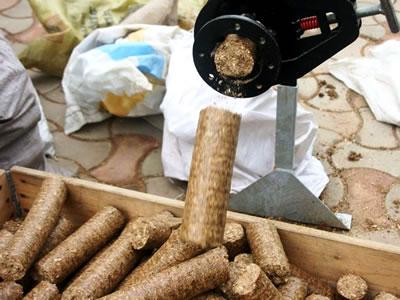

Among the professional equipment, one can distinguish a screw, impact-mechanical and hydraulic press. The first device is capable of delivering octagonal elements with a small hole in the center. They are distinguished by their maximum density, therefore they provide the longest burning time. The hydraulic press produces rectangular elements with the lowest density, which ensures high material consumption. Making fuel briquettes at home using a shock-mechanical device gives you the opportunity to make material of any shape. Moreover, the elements have an average density.
You can make a machine for making briquettes at home. To do this, you need a simple press and mold (sewer pipe with drilled holes). Please note that during the manufacture of the presented product, you will need to take into account the length of the firebox.
Effects
Modern faux fireplaces not only replicate the look of natural options, but also have some interesting effects.
The aroma of a burning fireplace
The main task of the false fireplace is to imitate the hearth of the flame in the apartment. To improve the realism of sensations when contacting such a structure, it is necessary to provide the aroma of burning wood in the room.
To do this, you will need to purchase any suitable incense or set fire to thin splinters, having previously protected the room from ignition.
Crackling dry logs
An indispensable attribute of the simulated fire realism is the characteristic sound of crackling firewood. It can be provided by recording the sound of a fire or downloading a finished audio file. Having chosen a natural volume level, it is necessary to turn on this sound on the MP3-player and install it in the general scheme of the fireplace. When the structure is connected to the electrical network, the crackle will start automatically.
Real warmth from a cold fire
When setting up a simulated flame in a home, most people install a fireplace without heating. However, it is problematic to achieve a realistic focus without a thermal effect. Therefore, an air conditioning system can be installed above the fireplace. However, the presence of characteristic noise can impair the resting atmosphere.
Alternatively, a silent air heater is suitable, which will not only improve the realism of the simulation, but also become an additional source of heat.


Material manufacturing technology
The production of fuel briquettes consists of several stages:
1. First you need to grind the waste that will be used for the production of elements.
2. Add dry clay to the same container, which will serve as a connecting link.
3. Now add water to this mixture. Moreover, the gruel should not turn out too liquid or thick. In any case, the mass should be well molded. In addition, the density of the briquette depends on the amount of water.
4. The resulting mixture must be poured into a mold and flattened with a press. Make sure that as much water as possible comes out of the gruel. After that, the resulting products must be thoroughly dried in the sun. In order for them to be durable, each element should be covered with paper or rags. Once completely dry, all the briquettes can be folded together.
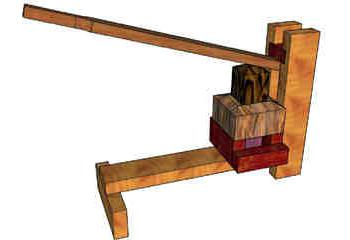

When you press the raw material with a press, you will have to make a lot of effort to squeeze as much water out of the mixture as possible.
Preparation of source material
Briquette press
The main problem in the self-production of fuel blocks is the need to grind the raw materials. Of course, when using sawdust, small shavings, and grain husks, this operation is not required. But small branches, shavings, cardboard waste, before briquetting, must be crushed until uniform particles are obtained.
Any household agricultural crusher can be used for grinding, in which hammers are replaced with cutting blades. In the backyard, these tools are commonly available and used to prepare feed for pets and poultry.
A city dweller with a garden or suburban area will have to find a suitable model in a garden supply store. Today, special devices are also produced for crushing household waste and garbage.
By purchasing this crusher, the summer resident will be able to use it not only for the preparation of briquette source material, but also for other purposes.
Useful Tips
Do-it-yourself production of fuel briquettes is quite simple, although laborious. Please note that the moisture content of each product should not exceed 13%. In order for the element to burn better, during manufacture, you can add paper, which needs to be torn into small pieces. And so that all the constituent parts stick together better, you can add a little starch to the mixture.
Please note that you will need different briquettes for different types of heating devices. For example, peat and birch elements are well suited for fireplaces. For baths, saunas and barbecues, it is better to use eurowood or wood briquettes. They can both burn and smolder slowly.In addition, they practically do not emit any carcinogenic or other harmful substances.
Now you know how to make a fuel briquette with your own hands. Good luck!
How to make cardboard fireplace logs
As mentioned, you can decorate your fireplace insert with decorative corrugated cardboard logs. It is quite simple to make such logs and it will not take you much time. On corrugated board, you need to measure the length and width and cut off the necessary strips. Then these strips need to be rolled into tubes. After that, you need to fix the remaining edge with glue, until it is completely dry, you need to tie the resulting logs with a rope.
Make biofuel for heating. Such fuel can be used in various types of stoves, barbecues, potbelly stoves and so on. The process of making it is quite simple, and all the necessary components can be easily found, and free of charge.
The main task set by the author is to use sawdust as fuel. Finding them is quite simple and in most cases it doesn't even cost anything. But there is one caveat, in its natural form sawdust smoke very strongly, burn poorly and emit little heat. To solve this problem, the author decided to make briquettes from sawdust, and paper will be used as a binder. How exactly to make such briquettes will be discussed below.
Materials and tools for manufacturing: - sawdust (can be found at sawmills); - paper (old books, newspapers and so on will do); - press; - thick plywood; - a plastic cylinder (a piece of a sewer pipe will do); - trough or bucket for mixing components; - water; - drill, hacksaw and other tools.
Manufacturing process:
Step one. How to create a mold for forming briquettes
First you need to find a plastic cylinder of a suitable diameter, the author used a piece of sewer pipe for this purpose. Next, a drill is taken and rows of holes are drilled in the cylinder. They are needed so that water comes out of the cylinder during the formation of briquettes.
When the holes are drilled, you can start making the top and bottom of the device. First of all, the bottom is made, it is made from a piece of thick plywood. As a result, the cylinder will have to be placed on the mold; no other mounting methods are provided. You can understand what the shape of the bottom of the cylinder should be from the photo. As for the cylinder cover, it is also made from a thick piece of plywood. As a result, the cover must enter the cylinder, it will be a kind of piston that will compress the contents of the cylinder. Step two. Create a mixture
Now you need to create a mixture from which briquettes will be formed. You need to take paper and dissolve it in water to get a mushy mass. The paper dissolves in cold water for about 30 minutes, in hot water for 5-10 minutes. Further, sawdust should be added to this pulp based on the fact that one part of the paper accounts for two parts of sawdust. All the resulting porridge must be thoroughly mixed.
Step three. Formation of fuel briquettes
Now you need to take the cylinder and set it to the bottom. Then you can start pouring the mixture. You need to pour under the neck. Subsequently, the cylinder is covered from above with a lid and placed under a press. After the water has been displaced, the finished briquettes can be removed from the cylinder. That's all, now all that remains is to lay out the made briquettes in the sun or in a barn so that they dry. It takes about three days to completely dry. After the briquettes are dry, they can be folded, thereby getting ready for the heating season. If there is a sawmill nearby, such
Today, special attention in the interior is paid to the issue of decoration. Most of the installed fireplaces do not function as heating, but as a decoration.And the usual types of fuel are being replaced by biofuels or electricity. Therefore, making a dummy firewood for an electric fireplace with your own hands is considered a fairly popular topic.
Use of paper in the manufacture
Paper briquettes
Waste paper can also be used to make fuel briquettes. At the same time, it can play not only the role of fuel, but also perform the function of a binder for sawdust, replacing clay.
There is a lot of glue in paper and cardboard, which, when swollen, will be an excellent binder when using sawdust. However, briquetted and dried paper and cardboard are themselves excellent combustible materials.
Unfortunately, when preparing the initial mass, paper and cardboard waste cannot be crushed in a crusher. They will have to be torn or cut into small pieces, no more than 2.0 × 2.0 centimeters in size.
Many summer residents, after a single cutting procedure, curse everything in the world and prefer to return to clay. Slow "homemade products" are used to grind the cutter of the food processor.
The sequence for preparing paper pulp is as follows:
- Shredded pieces of waste paper
pour warm water and wait for them to completely soak. - The resulting slurry after draining excess water
briquetted or mixed with sawdust. - Further pressing and drying operations
are similar to the processing of a clay-based mixture.
By experimenting with the percentage of paper and sawdust, you can create your own briquetted fuel recipe. For example, some gardeners add starch to increase its strength. Of course, you don't need to buy starch on purpose, but at the dacha there will always be old stocks that have survived the winter or a bug has wound up in them.
Fuel briquette is an alternative material that allows you to quickly and efficiently heat a stove or fireplace and warm up the room. However, it has many other advantages. Today this type of fuel is becoming very popular. Let's take a look at why.
What is a decorative fireplace
A full-fledged hearth with a chimney, a firebox, a real living fire is a luxury not available to everyone. The designers suggested that the imitation of the fireplace would look very advantageous in the home interior. Such a decorative object can be not only a simple decoration, but also a functional piece of furniture - a shelf for books, CDs, home photos.
DIY decorative fireplace
Dreaming of a home, you can create an artificial fireplace with your own hands or purchase a finished product. A simple decorative solution is an electric false fireplace in the interior, it can be purchased at any home appliance store. An electric fireplace is suitable for rooms that require additional heating. An eco-fireplace looks interesting, it uses ethyl alcohol with the addition of bioethanol to create an even flame without smoke, soot. The biofireplace in the interior is very popular, not only floor-standing, but also tabletop, wall-mounted eco-friendly hearths are used
Drywall
Ready-made bio- and electrical devices, although they look attractive, do not always fit the interior, and are not affordable for everyone. An interesting solution is decorative plasterboard fireplaces. A non-standard fake hearth will allow you to transform the living room without spending a lot of money
Another important advantage: you can decorate the original structure in any style, using stone, brick, wood, forging
First, it is worth preparing a full-size drawing in order to calculate the dimensions of the structure, individual elements. You will need, in addition to drywall sheets, metal profiles, self-tapping screws for metal. Step-by-step instructions will help you implement the project:
- A frame made of a metal profile is attached to the wall, which will play the role of a supporting element, a frame is made from a profile, self-tapping screws are used.
- The frame is sheathed with plasterboard.
- Plasterboard joints, fastening points of self-tapping screws are sealed with putty, leveling, surface grinding is performed.
- The fireplace is decorated with artificial stone, a ceramic plate, it can be decorated with decorative elements made of polyurethane, a decorative grill.
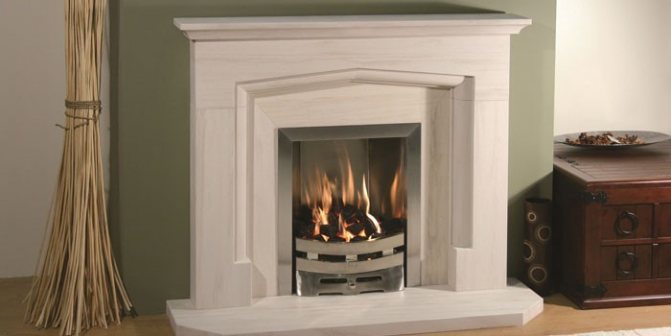

Made of cardboard
When you want to create an inexpensive but spectacular decoration on the eve of the New Year holidays, a decorative cardboard fireplace will ideally fulfill this role, especially if you take care of the decoration: garlands, New Year's boots, candles. You need to prepare:
- thick cardboard (you can use packaging from household appliances);
- construction tape;
- PVA glue;
- tools.
Having estimated the dimensions of the future object, having prepared the drawing, you can get to work:
- Using a sharp stationery knife, scotch tape, PVA glue, a portal is created from cardboard. It is more difficult to carry out a corner fireplace. Having accurately measured the angle, you need to calculate the dimensions of the structure so that large gaps do not form between the walls and the upper tabletop.
- The front part of the decorative fireplace is trimmed with polyurethane moldings, including around the firebox.
- When all the parts are firmly fixed, the structure is putty, leveling all errors, and polished.
- Painting is carried out with water-based paint.
Styrofoam
If there are materials left from the repair, you should try to make a decorative foam fireplace. It will turn out to be an inexpensive imitation of a fireplace in an apartment, if everything is done correctly:
- Styrofoam sheets are cut with a clerical knife: two pieces measuring 60x40 cm and two 40x20 cm.
- The workpieces are glued at right angles to the joints, lubricated with PVA glue and fixed with wooden toothpicks, tape from the inside.
- In the front of the frame, a firebox is cut out with a knife.
- The frame must be primed, cleaned with fine sandpaper, painted with water-based paint.
- The decor is carried out with an elegant ribbon, finishing paper, polyurethane skirting boards, moldings, decorative elements.
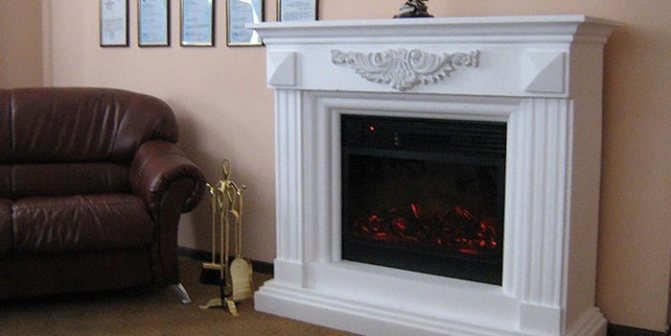

Solid and functional will turn out a false fireplace made of wood. An accurate drawing will help to avoid mistakes and unnecessary waste of material. The frame is made of a wooden beam with a section of 40x40 mm, plywood is used for sheathing. With some experience in carpentry, such an object can be made in a few evenings:
- The timber is marked, with the help of self-tapping screws for the tree, the base of the fireplace is made. Vertical racks are fastened to the wall with dowel-nails.
- Plywood sheet with a thickness of 0.5-0.7 cm is marked and cut with an electric jigsaw or a hand hacksaw in accordance with the dimensions. Sections are processed with sandpaper.
- Plywood is attached to a wooden frame with self-tapping screws, sheathing the base and the firebox.
- The decor of the fireplace is carried out using a finishing film, wallpaper, decorative panels, polyurethane moldings and moldings.
Fuel briquettes at home
It is completely unrealistic to imagine a situation when someone decides to purchase such a powerful unit capable of pressing briquettes at home. Even if finances allow doing this, and raw materials will be obtained for free, it will be possible to recoup the acquisition only in the event of a large-scale sale of the manufactured fuel.
In other words, it is clear that it will not be possible to implement the traditional method, which would release lignin, at home. But numerous home craftsmen have learned through trial and error to use other binding materials.
Raw materials and preparation
- corrugated cardboard, paper;
- the cheapest glue, for example, wallpaper;
- clay.
Savvy homeowners have gotten used to pressing heating briquettes from a variety of available materials that can burn:
- from paper,
- leaves,
- straw,
- cardboard,
- husks of seeds and other things.
- Sawdust is placed in water, clay is added there in a ratio of 1 to 10, stirred well, then inexpensive wallpaper glue or soaked cardboard is added to the composition.
- The mixture obtained in this way is placed in a homemade compression mold, and squeezed as tightly as possible with the effort of the hands.
- The formed rectangles are taken out of the mold and laid out to dry outside in a natural way.
Mechanism with a manual screw drive


The simplest press for the production of fuel bars, which you can make yourself, has a manual screw drive.
The design of this mechanism is extremely simple. But the performance of such a screw device is also low - this explains their low popularity.
A special molding container with holes is filled with the ready-made mixture, the screw is tightened tightly, creating an increased pressure.
Brick ejection mechanism
It is much easier and much faster to squeeze out the formed briquettes on another press. It is also homemade, but it has a long lever and a special device for pushing out a brick. To speed up the process, some people weld not one shape to the bed, but a pair.
